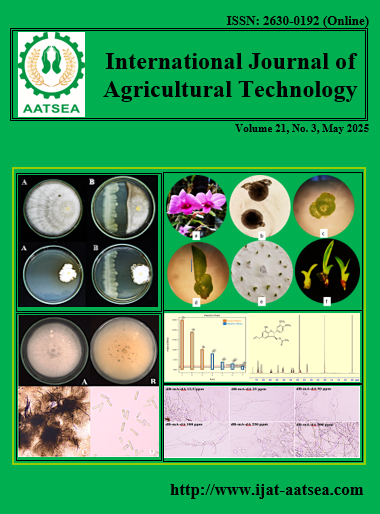Concentration of Nitrogen-corrected apparent metabolizable energy, nutrient and dietary fiber digestibilities of Banana meal in Broilers
Main Article Content
Abstract
Apparent metabolizable energy (AME), corrected to zero nitrogen retention (AMEn) is frequently used energy system to estimate energy concentration of an ingredient and diet in poultry. Meanwhile, apparent total tract digestibility (ATTD) is commonly used to estimate nutrient digestibility values of particular ingredient in poultry like broiler. The nitrogen-corrected apparent metabolizable energy, nutrient and dietary fiber digestibilities of banana meal in broilers was determined in this study. Results revealed that peeled banana meal was significantly higher (P<0.05) in terms of AME and AMEn in broiler than unpeeled banana meal with 3,369 and 3058 kcal/kg DM, respectively. But these energy values were less than the yellow dent corn with 3, 606 kcal/kg, DM. On the other hand, % ATTD of DM, GE and crude fiber of diets with banana meal were significantly higher (P<0.01) than corn-soy diet. Specifically, % ATTD of GE of diets with peeled banana meal was significantly higher (P<0.01) than diets with unpeeled banana meal. In conclusion, banana peeled meal can be used as an alternative feed energy source in broiler.
Article Details

This work is licensed under a Creative Commons Attribution-NonCommercial-NoDerivatives 4.0 International License.
References
Almeida, F. N. and Stein, H. H. (2010). Performance and phosphorus balance of pigs fed diets formulated on the basis of values for standardized total tractdigestibility of phosphorus. Journal of Animal Science. 2010 88: 9: 2968-2977. DOI: https://doi.org/10.2527/jas.2009-2285
AOAC. (2007). Official Methods of Analysis. Association of Official Analytical Chemists International, Washington, DC. 18th ed. 3rd rev.
Bezerra, C.V., Da Cruz Rodrigues, A.M., Manoel, A., Amante, E.R and Meller Da Silva, L.H. (2013). Nutritional potential of green banana flour obtained by drying in spouted bed. Rev. Bras. Frutic., Jaboticabal - SP, v.35, n. 4, pp 1140-1146 DOI: https://doi.org/10.1590/S0100-29452013000400025
Castillo-Israel, K.A.T., Baguio, S.F., Diasanta, M.D.B., Lizardo, R.C.M., Dizon, E.I. and Mejico, M.I.F. (2015). Extraction and characterization of pectin from Saba banana [Musa ‘saba’(Musa acuminata x Musa balbisiana)] peel wastes: A preliminary study. International Food Research Journal 22(1): pp 202-207.
Donkoh, A., Attoh-Kotoku, V., Kwame, R.O. and Gascar, R. (2012).
Evaluation of nutritional quality of dried cashew nut testa using laboratory rat as a model for pigs. The Scientific World Journal Volume 2012, Article ID 984249, 5 pages doi:10.1100/2012/984249. DOI: https://doi.org/10.1100/2012/984249
Faisant, N., Buleon, A., Colonna, P., Molis, C., Lartigue C. S., Galmiche, J.P. and Champ, M. (1993). Digestion of raw banana starch in the small intestine of healthy humans: Structural features of resistant starch. British J. Nutr. 73:111-123. DOI: https://doi.org/10.1079/BJN19950013
Fetuga, B.L. And Oluyemi, J.A. (1976). The metabolizable energy of some tropical tuber meals for chicks. Poult. Sci.,55 (3): 868-873. DOI: https://doi.org/10.3382/ps.0550868
Gallant, O., Bouchet, J., Buleon, A. and Perez, S. (1992). Physical characteristics of starch granules and susceptibility to enzymatic degradation. European Journal of Clinical Nutrition, 46 (Suppl. 2), S3-S16.
Heuzé, V., Tran, G., Archimède, H., Lessire. and Renaudeau, D. (2016). Banana fruits. Feedipedia, a programme by INRA, CIRAD, AFZ and FAO. https://www.feedipedia.org/node/683.
Hill, F.W. And Anderson, D.L. (1958). Comparison of metabolizable energy and productive energy determinations with growing chicks. J. Nutr. 64:587–603. DOI: https://doi.org/10.1093/jn/64.4.587
Ibrahim, M. A., Holmann, F., Hernandez, M. and Camero, A. (2000). Contribution of erythrina protein banks and rejected bananas for improving cattle production in the humid tropics. Agroforestry Systems, 49, 245-254. DOI: https://doi.org/10.1023/A:1006379427315
Mateos, G. G, Jimenez-Moreno, E., Serrano, M.P. and Lazaro, R.P.
(2012). Poultry response to high levels of dietary fiber sources varying in physical and chemical characteristics. Poultry Science Association, Inc. J. Appl. Poult. Res. 21:156-174. DOI: https://doi.org/10.3382/japr.2011-00477
Padam, B.S., Tin, H.S., Chye, F.Y. and Abdulla, M.I. (2012). Banana byproducts: an under-utilized renewable food biomass with great potential. J Food Sci Technol :51(12):3527–3545. DOI: https://doi.org/10.1007/s13197-012-0861-2
Renaudeau, D., Brochain, J., Giorgi, M., Bocage, B. and Herv, M. (2014). Banana meal for feeding pigs: Digestive utilization, growth performance and feeding behavior. Animal, 8: 565-571. DOI: https://doi.org/10.1017/S175173111400010X
Sauvant, D., Perez, J. and Tran, G. (2004). Tables of composition and nutritional value of feed materials. 2nd ed. Wageningen Academic Publ., the Netherlands. DOI: https://doi.org/10.3920/978-90-8686-668-7
Svihus, B. (2014). Starch digestion capacity of poultry. Poultry Sci. Vol. ISSN 0032 5791.pp 2394-2399. https://doi.org/10.3382/ps.2014-03905. DOI: https://doi.org/10.3382/ps.2014-03905
Tester, R. F. and Karkalas, J. (2002). Starch. In E.J. Vandamme, S. de BAets, & A. Steinbuechel, Polysaccharides II. Biopolymers (Vol 6) pp. 381-438. DOI: https://doi.org/10.1002/3527600035.bpol6013
Topping and Clifton, D.L. (2001). Short-chain fatty acids and human colonic function: roles of resistant starch and non-starch polysaccharides. Physiol. Rev., 81: pp. 1031-1064 DOI: https://doi.org/10.1152/physrev.2001.81.3.1031
Walugembe, M. (2013). The effect of high and low dietary fiber diets on the performance of two lines of chickens with divergent growth rates. Graduate Thesis and Dissertation. Paper 1336.
Zhang, P., Whistler, R.L., Bemiller, J.N. and Hamaker, B.R. (2004). Banana starch: production, physicochemical properties, and digestibility – A review. Carbohyd Polym. 59: 443-458. DOI: https://doi.org/10.1016/j.carbpol.2004.10.014


